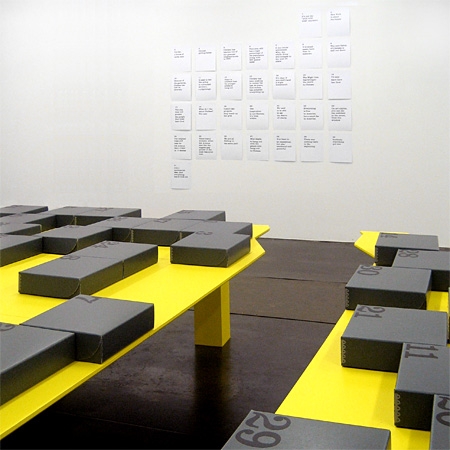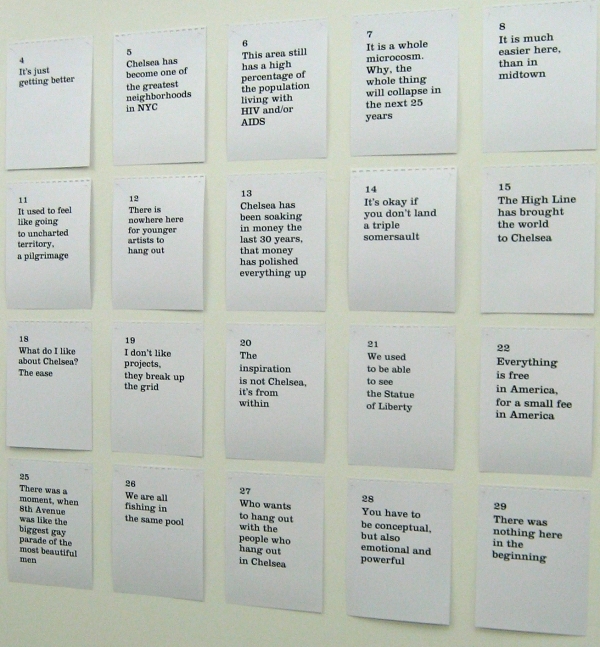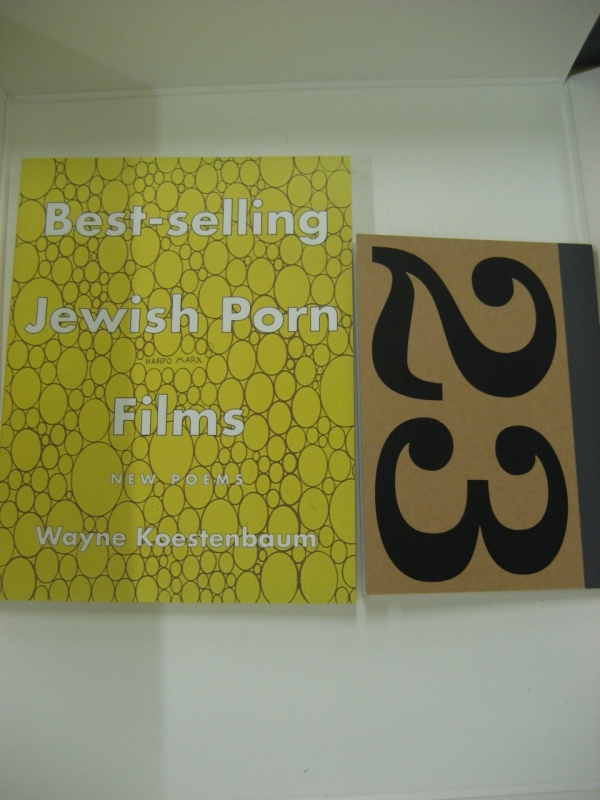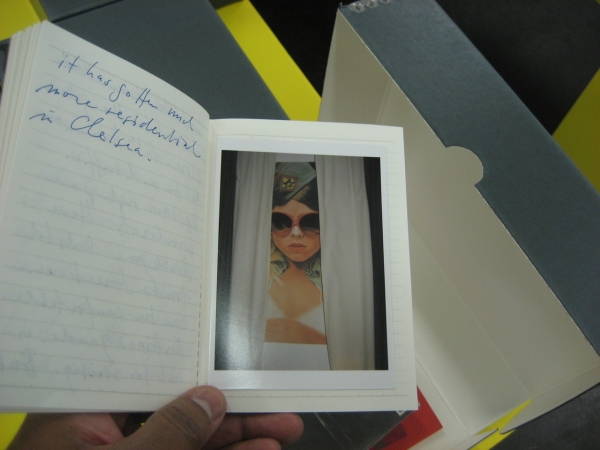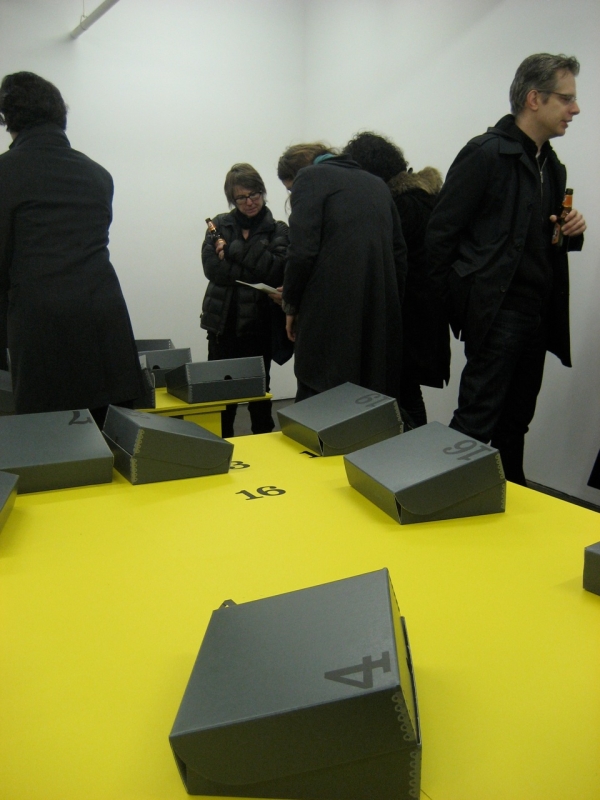31 in Chelsea
<strong style=\"text-align: justify\">8 January – 19 February 2011
<strong style=\"text-align: justify\">Murray Guy Gallery, New York, USA<strong style=\"text-align: justify\">
Archive of 31 boxes, performance at 1OAK
© Christian Philipp Mueller for <span style=\"text-align: justify\">Murray Guy Gallery, New York, 2011
<p style=\"margin: 0.1pt 0cm\" class=\"MsoNormal\"><span style=\"font-size: 10pt; font-family: Times\">During the past few years Chelsea became a one-stop shopping destination for high-style contemporary architecture as well as high-end art, and the results can be depressing. For every significant building that went up, the neighborhood seemed to produce a half-dozen or so inferior knockoffs. The feeling on the streets now is the same as it is in most of the galleries: the sheer amount of work, and the mediocrity of most of it, can make the effort of sorting out the good from the bad too painful to contemplate.
<p style=\"margin: 0.1pt 0cm\" class=\"MsoNormal\"><span style=\"font-size: 10pt; font-family: Times\"> <p style=\"margin: 0.1pt 0cm\" class=\"MsoNormal\"><span style=\"font-size: 10pt; font-family: Times\">Christian Philipp Müller’s “31 in Chelsea” took up the rapidly changing neighborhood where Murray Guy has been located since its establishment in 1998. This new work built on two previous projects: <span style=\"font-size: 10pt; font-family: Times\">“<span style=\"font-size: 10pt; font-family: Times\">Interpellations,” presented in 1994 at American Fine Arts Co. in Soho, in which Müller inserted mock entries for the art gallery into New York travel guides, and <span style=\"font-size: 10pt; font-family: Times\">“<span style=\"font-size: 10pt; font-family: Times\">Around the Corner,” conceived in 2006 at Orchard on New York’s Lower East Side, during which he offered a series of guided walking tours of the gallery’s environs. In both of these works, Müller staged a cluster of relations between specific art galleries and broader neighborhoods and inhabitants, coordinating “disconnected times and spaces to bring the contradictions of the present into a sharper focus.” <p style=\"margin: 0.1pt 0cm\" class=\"MsoNormal\"><span style=\"font-size: 10pt; font-family: Times\"> <p style=\"margin: 0.1pt 0cm\" class=\"MsoNormal\"><span style=\"font-size: 10pt; font-family: Times\">Müller’s project examined the structure of an urban neighborhood at a time when the very concept of a neighborhood—whose components are defined by their geographic proximity—is itself being rapidly reshaped by new forms of communication, exchange, and circulation. Beginning with the question “What is Chelsea?,” Müller arranged 31 visits and conversations with a broad cross section of Chelsea residents, organizations, and businesses. Not programmed by any overall sociological or demographic strategy, his visits comprised a sort of derivé, where one encounter lead to another. These ranged from the Hudson Guild Senior Center to the Gay Men’s Health Crisis, a nightclub promoter, an executive at Google, a painter, and a restaurant owner, to name but a few. <p style=\"margin: 0.1pt 0cm\" class=\"MsoNormal\"><span style=\"font-size: 10pt; font-family: Times\"> <p style=\"margin: 0.1pt 0cm\" class=\"MsoNormal\"><span style=\"font-size: 10pt; font-family: Times\">Müller used the gallery to stage the traces from his visits, organizing this archive into 31 boxes (one for each day of the show), which confronted the viewer as a hybrid between a portrait, a map and a calendar. On January 14 at 6:30pm, he gathered his collected material into a performance, presented at the nightclub 1OAK, which has been located for the past 3 years in a lavishly renovated space below Murray Guy. <p style=\"margin: 0.1pt 0cm\" class=\"MsoNormal\"><span style=\"font-size: 10pt; font-family: Times\"> <p style=\"margin: 0.1pt 0cm\" class=\"MsoNormal\"><span style=\"font-size: 10pt; font-family: Times\">Müller’s attempt to represent an expansive neighborhood like Chelsea over 31 days in a commercial art gallery involved a degree of absurdity, within which we might locate a space for reflecting on the gallery’s relations to its surroundings and to its audiences, relationships which involve different registers of visibility and invisibility, connection and “autonomy.”
